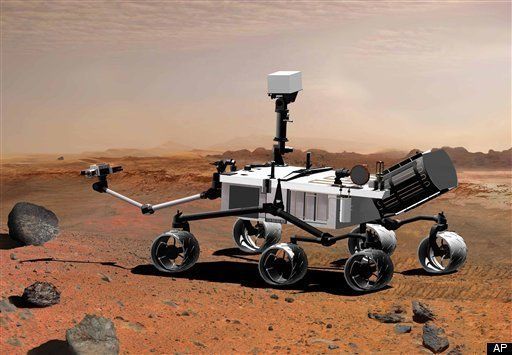
Every time the Jet Propulsion Laboratory sends a mission to Mars, I tell my non-technical friends that what they do is like teeing off in St. Andrews and making a hole-in-one at Pebble Beach -- with the same ball! It's very, very, very hard: a 100,000,000,000-yard Par 5.
Good thing it's a robot, however. The acceleration to send it on its way and the deceleration to land on Mars would reduce a human being to a pile of bloody Jello. Even the robot sits out the ride in a defensive crouch, carefully unfurling only after it's safely on the surface of Mars.
Scientists have been itching to bring a Mars rock back to Earth. But it keeps proving to be a mission too far for NASA's engineers and budgeters. The technical reason is that the return vehicle has to be sent all the way to Mars, and it is heavy, complex, and expensive. Put in economic terms, it costs an ounce of gold to put an ounce of anything in low Earth orbit, but it costs a ton of gold to bring an ounce of anything back from Mars. It's cheaper to develop a more sophisticated robotic laboratory and send it one-way to Mars than to bring anything back to look at in a laboratory on Earth.
The economics of manned space travel are even more extreme. For that reason, science fiction writers for the last generation have given up on the notion of an Apollo-like program, sending humans to Mars and back. Instead, they envision one-way missions. In one version, the astronauts are geezers, active senior citizens who would rather end their days exploring Mars than in retirement homes.
In more common versions, the people are colonists, whose children and grandchildren will know Earth only as a bright blue speck in a red sky. Their way is paved by decades of robot landings on Mars, first exploring and later providing enough infrastructure for the colony. The sci-fi writers envision hundreds of robotic landings on Mars before people arrive and a private/public sector cooperation to make space travel much less costly and routine.
I had a fore-taste of this 15 years ago. As a senior AT&T executive, I was invited to a private briefing on the Iridium Project: a hugely ambitious plan to put a "constellation" of over 700 communications satellites in low Earth orbit. Their full plan never got off the ground, so to speak, because it could not compete with the economics of conventional cell phone service. But the promoters made a point that stuck with me.
"Look at the innards of a spacecraft," they said. It looks more like a World War II vintage airplane than something modern - like a P-51, not a PC. That is because every spacecraft is a one of a kind item, custom-made for its single use in a single mission. What if they were mass produced? Like, say, computers or automobiles. The design would become sleek, user-friendly, and cost-efficient.
That is the opportunity presented by the Obama-Bolden budget for NASA. It continues the robotic exploration of the solar system and beyond, but re-directs the manned space effort into a period of trying to start a meaningful private sector space industry. The first challenge for the private sector is one of the most fundamental: greatly reduce the cost of getting from the Earth's surface to Earth orbit. If we can do that, then the bigger dreams can start to become affordable realities.
Inspiration for the Apollo program can be found in the science fiction of the 1930s, as writers extrapolated from Robert Goddard's early work to envision reaching the Moon. It would not be a surprise if the next generation of manned space exploration turned out not to be a repeat of the vision of 1930's science fiction writers, but instead one foretold by the writers of the 1990s.
The author is a member of the Board of Trustees of the California Institute of Technology, and serves on its JPL Committee. The views expressed in this post are strictly the author's and do not reflect positions of JPL, NASA, or Caltech.
